Do you struggle to plan meals once a week, or once a month, or ever really, even just a little bit? Just because we have come to a place of permission, where all foods fit in theory, doesn’t mean that all foods automatically exist in our lives! So how the heck do we manifest that food, within reach, at the times we need it?
Well, to start, we must let go of perfect. Diet culture a la social media has tricked us into believing that meal planning has to be perfect meal planning. You know what I’m talking about. The jade green slice of avocado toast perched atop white china, taking in the views from some seaside bistro table. The glass-smooth protein balls arranged in a Fibonacci spiral on Gwyneth Paltrow’s golden cake stand in the California sunshine. The bowl of homemade yogurt, white on black stoneware (so chic), jeweled with super-saturated blueberry/sapphires and pomegranate/rubies. Hashtag bento box. Hashtag overnight oatmeal. Hashtag spotless new Sub-Zero opened to reveal row upon row of rainbow salad jars at attention.
Recall that it wasn’t always this way. In the Middle Ages, for example: people used to subsist (I assume) day in and day out on burnt hunks of meat, gray porridge, random birds, maybe a handful of dandelion greens thrown in for color? Even today, there are remote traditional cultures that rely on a few food sources to meet most of their needs. But since the invention of Pinterest, Instagram, and the like, we live in a world flooded with images of plate-as-status-symbol. I’ll be the first to admit that nutritionists can be the worst offenders! These meals aren’t what is actually being eaten, but toxic, highly cultivated ideal depictions of an eating life that relies on incredible financial and time (and photographic equipment) privilege to execute. They are a textbook example of “the perfect is the enemy of the good,” because they keep real people paralyzed to fuel themselves. Seven days of meticulously crafted food/art just doesn’t work with any semblance of actual life!
So in the real world: of jobs and kids and salad jars dying a tragic brown freeze-thaw-cycle death on the top shelf of the Frigidaire, how can we stay nourished? Let’s start by keeping truth in mind: balanced nutrition isn’t dependent on infinite variety or complexity! Having a general mix of foods from the different food groups, with most food groups at most, but certainly not all, meals (or even on all days), is absolutely good enough to give our body the nutrients it needs! This gentle nutrition means some attention to planning for variety in our larder, but with an acceptance that satisfaction, pleasure, and just time to do other things all hold equally important places in our lives. And, especially if you are neuro-diverse (like easily-distracted me), taking a few simple steps to organize a flexible meal-planning system can go a long way towards actually making that delicious home cookin’ happen!
I call the approach I use “messy meal planning.” Messy because there are no rules. Messy papers. Messy lists. Messy implementation and re-organization of meals on the fly. It is organized chaos, and sure, the plates aren’t always pretty, but somehow, it works together to make tasty meals actually happen, which is the most important thing. Give it a shot, and you might find you can save money, feel empowered and self-reliant, and have the calm satisfaction that comes from a plan. Plus, if you like food as much as I do, it can be fun!
Let’s dive in together!
The first step
in thinking about what to eat is to make the thinking part easier. We could lie back in an easy chair and daydream for inspiration each time we want to plan, but I’ll bet your chock-full-of-to-do-lists-and-on-a-deadline brain is going to struggle! To make it easier, we want to have a collection of ideas ready to go. That means–
- Establish a collecting place. Before you even start meal planning, give yourself a few weeks (or months, if needed) to build up ideas. That way, when it is actually time to sit down and write out this week’s plan, a quick scan of the collection will reveal what sounds good. Think about whether physical (i.e. folders, binders, white board, lists on paper) or virtual (lists on phone, folder on computer, internet bookmarks) would work better for you.
- Start your collection. Oh yes, establishing the collecting place is a step all in itself! Start with this foundation. Buy the binder, or start the notepad. You’ll be surprised at how quickly the collecting place fills with ideas once you add to it little by little.
I’m an analog babe, so my collection is physical. I started with one folder, which expanded over the years to multiple binders (I use plastic binder sleeves to preserve and contain the paper madness). I tear pages out of magazines like Sunset and Bon Appetit (that I own of course!), make photocopies of my favorite cookbook recipes (the library is a great resource), and print out recipes that sound good at random from online searches and places like NYT Cooking. I also save all the lists I’ve made at various times for weekly meal ideas and family favorites. Recipes aren’t necessary if you prefer simple cooking. Even images of food that looks good can trigger this week’s inspiration!
Some pages from my collection
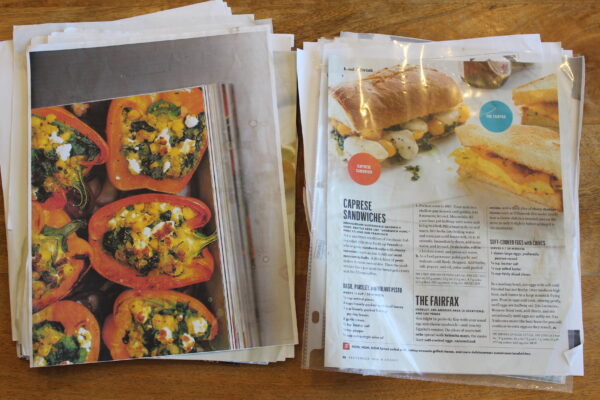
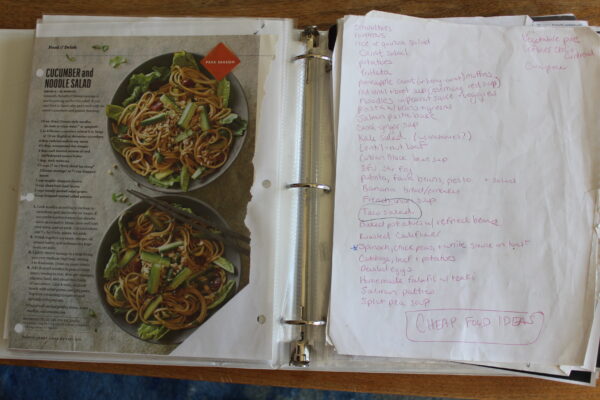
The second step
in meal planning is making time to make the meal plan. The actual looking through papers and coming up with ideas does take time. Not as much time as when there are no ideas ready to go, but still, a good 10-15 minutes or more. It helps to–
- Set aside calm time to make your plan. I find early in the morning over tea or late at night while I’m relaxing on the couch to work well. Meal planning is more pleasurable when it can be done sitting down with a blank piece of paper. Keep your calendar handy, too, because you’ll need to look at what is actually happening in your life next week to be realistic about expectations. Remember that the writing of the meal plan can be separate from the writing of the grocery list, so try to make a meal plan when it is convenient to sit down, not when the food has run out!
- Make the plan really simple, and then make it simpler. Our first instinct is always to plan too much, and too idealistically. Don’t be a Pinterest star. The meal plan doesn’t just include food you are making, but also food you are buying and times you plan to eat out. When you first start out, try to plan to do nothing most of the time! Rely on no-cook and just-grab food as much as possible, and add gourmet once you get into the swing of things only if time and interest allow. Creating the security of knowing-where-our-next-meal-is-coming from is so much more important than the actual where. When you set down the finished meal plan, it should feel easy, even if unexpected events arise.
- Add a column for “food on hand.” I usually jot these ideas on the right-hand side of my plan. These are foods you plan to either prepare or buy that will just be in the fridge for lunches, breakfasts, snacks, etc. I like leftovers and find it easier to plan dinners only, but even if you do add other meals to your plan, it is good to assume that once in a while we will really just need to grab a string cheese and run out the door!
- Be ready to create a stop-gap plan! I usually plan on a week to week basis and expect the unexpected, but that doesn’t mean it always works. Sometimes I didn’t plan enough or get really hungry, and the food runs out. Or sometimes my previous plan was too ambitious, or I go out of town. Whatever the cause, a meal-plan emergency is bound to arise every so often! If you don’t want to plan, or do a major shop, under pressure, just create a stop-gap plan for the next few days and figure out a time you’ll sit down to make the bigger plan.
Here’s a good example of a low cook plan:

Things feeling crazy? Just try for a stop-gap plan and shop for now:
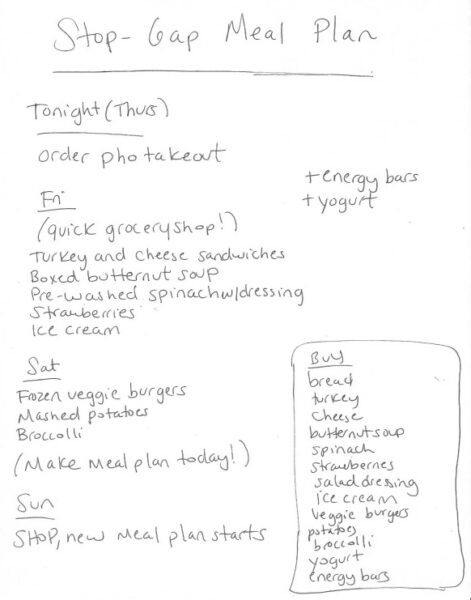
Here was my first draft of this week’s meal plan, created during a calmer moment on Thursday night:
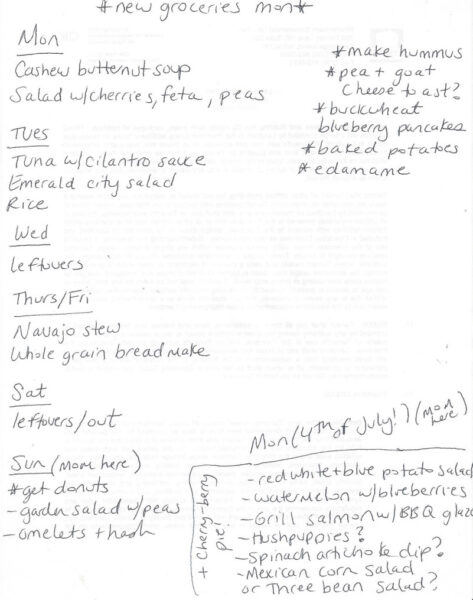
Here’s the second (final) draft I made of this week’s meal plan as I put together the grocery list on Sunday night. I realized with some rearranging and simplification I could stretch the current food until Wed:
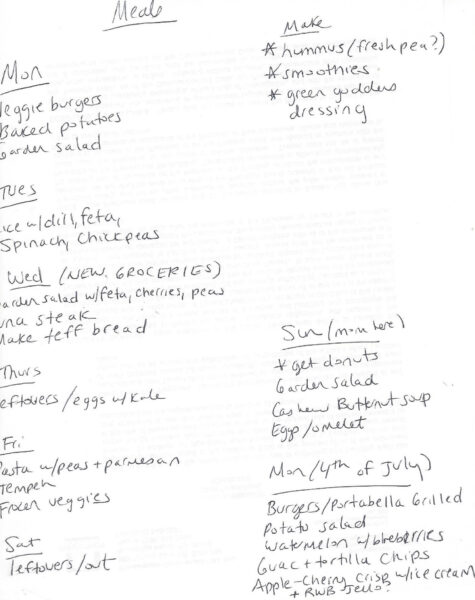
Finally, here’s how it turned out in the end. Note that there was some rearranging, and need for emergency take-out one night when things got busy! All the food was used in the end.
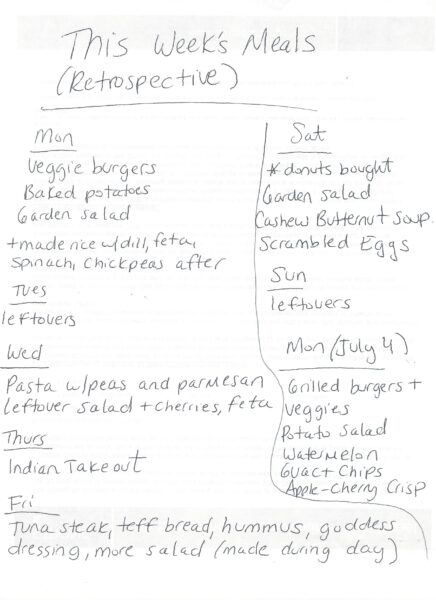
The third step
is to create the grocery list and buy food. If you have time, this can happen at the same time as the writing of meal plan, but it doesn’t need to:
- Think about detaching the meal planning from the grocery list writing: For me, this is a big stress-reducer! I like to write a grocery list within a day or two of shopping, but it can be nice to meal plan further in advance. I might make some tweaks to my plan as I go through the list, but since the big planning job is done, I can write a list quickly on the fly. We never know for sure when an unexpectedly empty fridge will trigger a trip to the grocery store, after all!
- Consider online grocery shopping: This pandemic-era change (most local grocery stores offer pickup and/or home delivery now) not only helps tamp down viral spread in a public place, it also creates a built-in structure for thinking-ahead-about-food. Waiting until the food in the house runs out to think about food is a dangerous game: one that can leave us hungry, cranky, and beset with cravings. Instead, get your brain used to the idea of filling your online cart a day or more ahead, while a little food still sits in the fridge. Fortunately, most of us are within an hour’s drive of a grocery store selling tasty vittles any day of the week if emergencies arise, but making this the exception rather the norm is an act of love towards our bodies: one that communicates that we are deserving of secure, consistent access to filling meals.
The fourth step
is to actually implement the plan! Remember that this can be messy. There is no rule that things can’t shift and change to suit your changing life. You took the first important steps, and got the food in the fridge! Now, improvisation and flexibility are key.
- It is ok to switch up the plan and make food on different nights from the ones listed! Some attention to spoilage is needed (try and use the freshest foods first), but since we can never fully know what will sound good on any particular day in advance, allow your body and cravings to dictate shifts and flip-flops. I often will just make part of a planned meal, rounding it out with something else, and then make the rest later, adding and subtracting as I go.
- You don’t have to cook and eat on the same night! If I had to just give one tip for successful home cooking and meal planning, this would be it. To respect our hunger, it is vitally important to feed ourselves when we are hungry. This means that on days when work ran later than expected, the 30-60 minutes we had budgeted to actually make tonight’s dinner may have evaporated. Instead of forcing your body to suffer, feed yourself now, and then cook! That’s what the “food on hand” is for. Grab a sandwich dinner, and then spend some relaxed evening time (or high-octane morning time) making a meal that will be delicious for tomorrow’s dinner.
Here’s an example of a meal plan in action! I keep mine front and center on the fridge and adjust often.
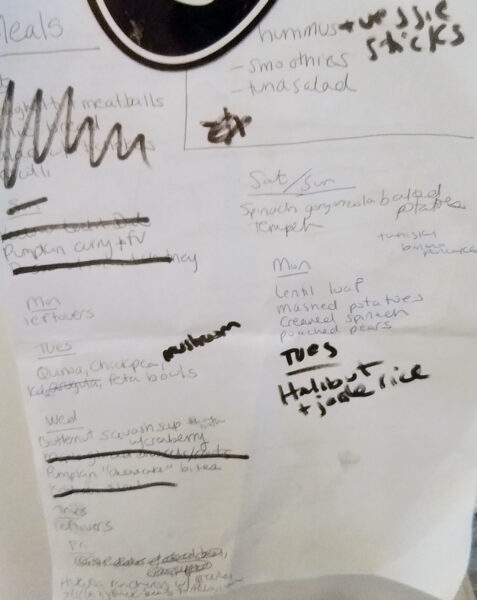
The final step
is to maintain the system over time. You’ve done a great job up until now starting a system, let’s keep it going! Continue to add to the recipe ideas collection over time to keep food exciting. I have actually collected so many recipes that I have my collection broken down into sub-collections. This allows me to view new food ideas while simultaneously simplifying into a manageable weekly stack.
My process today starts with the master collection of Meal Planning Binders. These are organized by food group/occasion and kept in a kitchen cabinet.
The Binders!
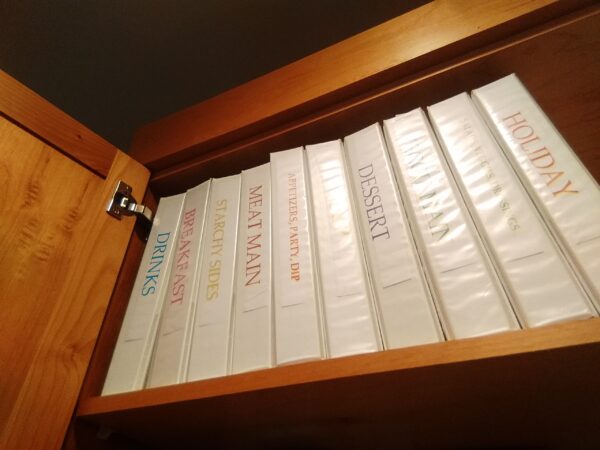
On bi-annual Meal Planning Binder Day, I curate the collection into a smaller collection of fall/winter or spring/summer ideas. (In practice, this means I take up the entire living room floor for a few hours with binder madness). Meal Planning Binder Day is a great opportunity to put back used recipes (some favorites are kept in the weekly folder perennially, while others repeat once a year or less) at the same time I pick new ideas.
Meal Planning Binder Day (Reenactment):
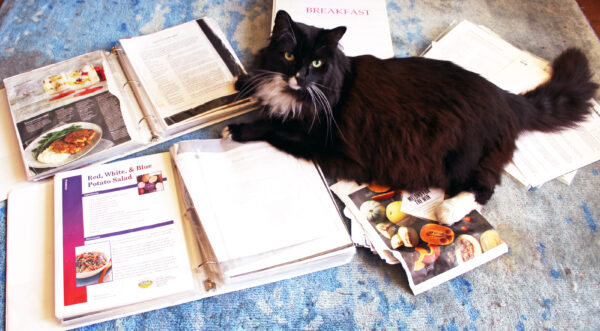
After pulling out my ideas for the next 6 months, I store them in an overstuffed Yellow Folder in a different kitchen cabinet closer to the action:
The Yellow Folder from whence inspiration springs
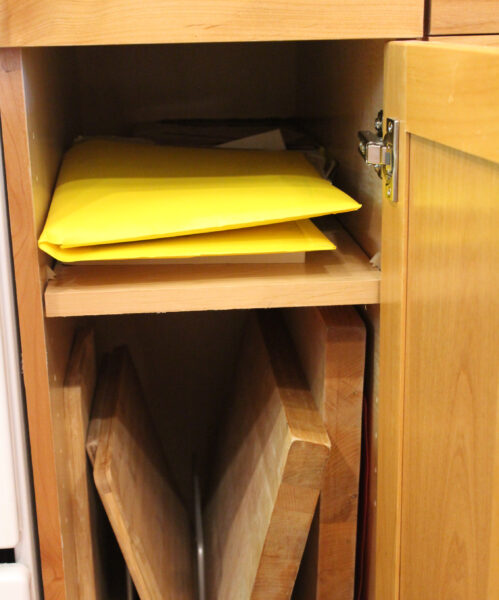
And, because my collection is so laughably unwieldly, and my boredom with the same old foods so limitless, around once a month I plop the Yellow Folder down in front of me on the breakfast table and pull out the ideas I actually want to use this month. These live in a Smaller Folder next to the fridge:
The Smaller Folder makes it happen
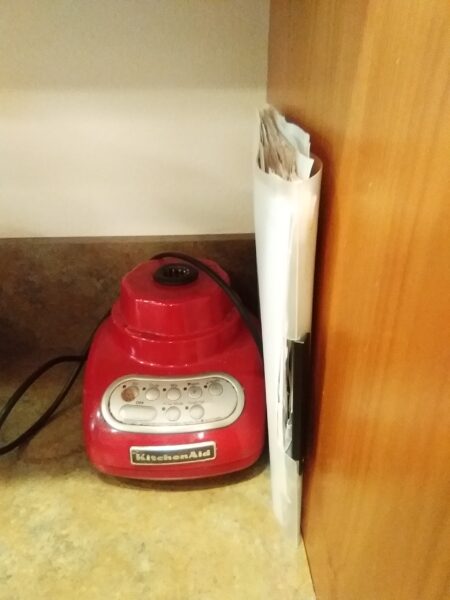
That way, when I actually sit down each week to plan the meals, I have a much more manageable mini-collection to choose from.
Weekly meal planning in action. (And flexibility in action: despite ambitiously listing “halibut” on most meal plans, I usually end up with cod. I hold out faith that one day the halibut will happen for us!)
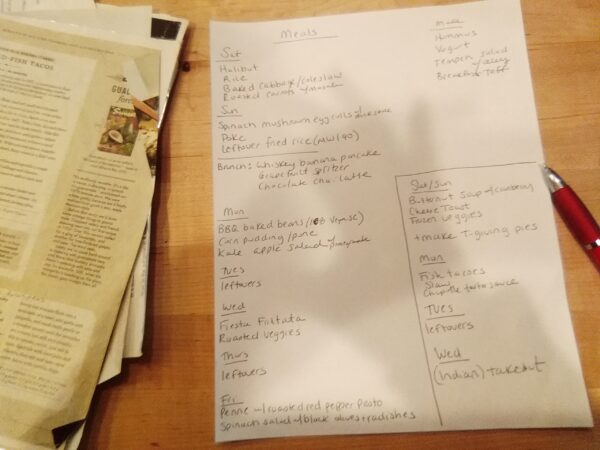
This is just my system, and a totally different one may work better for you. Maybe your collection is smaller, and you only need one folder, or two? Perhaps you think it is a good idea to organize a smaller number of binders by season and then just grab the Spring, Summer, Fall, or Winter binder when the time comes? Sure, great idea! Perhaps a digital collection is better for you, and you have some cool digital way to search it? Yes queen, do it! Messy meal planning is so personal, and I encourage you to find the personal way that works best for you and your family.
There's one last thing I bet you are wondering:
What about nutrition? How do I trust myself to craft a meal that gives me everything I need? When we are eating intuitively, the goal is to listen to what sounds good first and foremost, with trust that in a fully permissive eating plan, our bodies will naturally want a variety of foods that keep us well-nourished. But an eye to gentle nutrition is also a form of self-care. This more advanced intuitive eating concept (let’s discuss together!) describes a world in which our desires and inclinations play a starring role in choosing foods, while at the same time a loving “inner parent” reminds us that we usually feel better with all the different food groups in our life. Give space for this voice to gently guide and see how that feels. Look over the meal plan. Do the meals sound satisfying? Do they feel like something is missing? Remember that gentle nutrition is simple: check whether most of your meals include some protein/fat foods, some carbs, some produce. Will there be different types of snacks available? The loving inner parent plans for these different foods to be on hand in the fridge and ready-prepared. When mealtime comes, you are in charge! Eat what sounds and feels good to you, even if food groups are missing. You gave yourself the gift of food security; now you can always round out with something else at the next meal.
If you’d like support with starting your unique home meal planning practice, make an appointment today and let’s work through it tougher.
Bon appétit my friends!

